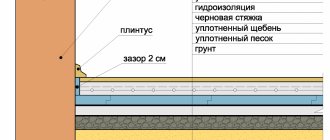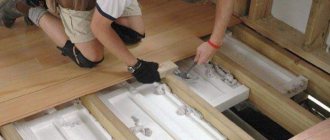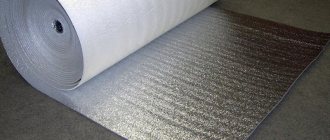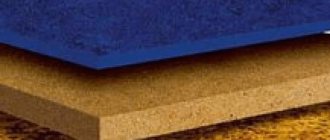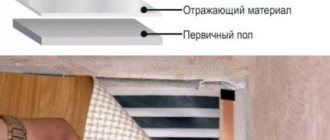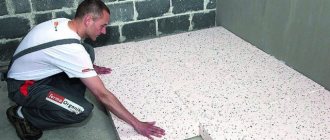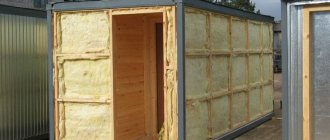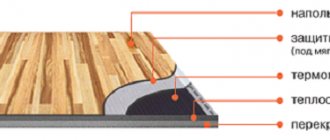Today the construction market presents a very wide range of floor coverings. The combination of a reasonable price and high quality is what sets linoleum apart from other coatings. Most linoleum is of artificial origin. This material is easy to install and maintain, which to some extent makes the coating so popular. However, if the floor in the room is cold, it will have to be additionally insulated before laying linoleum. This article will help you figure out what kind of insulation to put under linoleum on wooden floors, as well as on a concrete base.
Types of linoleum
Linoleum can have a base or be baseless. Baseless linoleum is very thin and requires special preparation before installation, since it quickly tears and wears out on an uneven surface. This coating will last up to five years, but it must be borne in mind that it has absolutely no sound or heat insulation properties.
If there is a basis, the following are distinguished:
- Foam base . It has a small thickness of about 1.5–3 mm. The foam backing retains heat to some extent and absorbs sound. It is very soft and elastic, easy to stick to corners. The base can be supplemented with fiberglass, which will protect the coating from deformation and dents. The top decorative layer is covered with a protective film, which will extend the service life of the linoleum.
- Warm base . It consists of natural or artificial jute or felt, protected by a polymer layer. A soft and elastic coating up to 5 mm thick is perfect for bedrooms and will retain enough heat. The disadvantages include the insufficient strength of the top layer. It requires special care and is not suitable for rooms with high air humidity.
Linoleum with a base will protect your feet from the cold to some extent, however, if the floor is too cold, it will still need to be insulated.
Plywood insulated floor
High-quality insulation of the base can be achieved by installing an insulated plywood floor along the joists. Logs can be used regular or adjustable. Adjustable joists are convenient to use if there are uneven floors. If the unevenness is small and regular joists are installed, the differences can be leveled by using wedges.
You can lay plywood without joists on a flat concrete surface, however, if the room is located above an unheated one, this option will not save you in the cold in winter.
Installation of plywood floor:
- Logs are installed on the screed at a distance of 300–600 mm from each other.
- If the insulation does not tolerate moisture, waterproofing is installed.
- Then thermal insulation is installed between the joists.
- The plywood is sawn into squares and laid with small gaps between the sheets, both between each other and against the walls.
- The sheets are fixed with self-tapping screws, recessing them into the thickness of the plywood.
- Gaps and screw heads are filled with elastic putty.
Video: installation of plywood floor with penoplex insulation
Advantages:
- Environmentally friendly.
- Low price.
- Strength.
- High degree of thermal insulation.
Flaws:
- Instability to moisture.
- Not installed in rooms with low ceilings.
Insulation under linoleum on a wooden floor - All about insulation and energy efficiency
Wooden floors lose their original appearance over time, the boards become deformed, and cracks appear between them.
Such a coating that becomes unusable ceases to retain heat and requires mandatory repairs and insulation.
Many home owners prefer to lay linoleum on top of the boards, but it will not solve the issue of insulation if the wooden base is not properly prepared.
Laying linoleum on a wooden floor
Laying linoleum on a wooden floor is the easiest solution to tidy up the interior of a room. But in order for the renewed floor to last for a long time, the work process must take place in stages, in compliance with all rules and technological recommendations.
Before you buy linoleum as a new flooring, you need to find out which type is best suited for flooring on wood.
Positive qualities of the material
Linoleum has always been popular as a finishing coating for floors of any type. This is a consequence of its many advantages over other materials.
The positive qualities of linoleum can safely include its following properties: wear resistance and elasticity, water resistance and strength, a variety of shades and patterns, simplicity and speed of installation, which can be done independently, without calling or paying specialists, and, of course, an affordable price, which for many it is a decisive factor in their choice.
Floor insulation with cork
Cork consists of the bark of the cork tree and is considered an environmentally friendly product. Installation is carried out in two ways:
- Floating way. The rolled material is rolled out over the surface, joint to joint. The sheets are connected with construction tape.
- Using glue. When laying cork slabs. Cork flooring can also be used as a finishing surface.
Video: installation of cork backing
Pros:
- Naturalness of the material.
- High sound and heat insulation.
- Wear resistance.
- Resistance to moisture.
- Can also be used for laminate and carpet.
Minuses:
- High price.
Preparing a Wooden Floor
However, despite all the nuances, it is quite possible to install heated floors made of wood with linoleum finishing. First of all, you should take care of preparing the wooden base itself for further work.
First, it’s worth assessing the condition of the wooden floor. It should be smooth and durable, the boards should not “walk”. All rotten and damaged boards should be replaced with new ones, and all cracks and gaps should be eliminated. If you neglect to seal the cracks, the heat will partially go under the floor and be lost, which means that the energy consumption for heating the base will increase. The nail heads need to be recessed into the wooden base so that they do not stick out. It is recommended to fill small holes with putty.
Wooden floors need to be properly prepared
Important! Linoleum, like the infrared flooring system, should only be laid on a very level base.
If necessary, the base can be leveled by laying sheets of plywood or other material on top and securing them. It is also recommended to treat wooden floors with an antiseptic and fire-resistant compound, just in case. And the outside of the boards themselves, if necessary, are polished using special equipment.
Leveling a wooden floor with plywood
Expanded polystyrene for linoleum
Expanded polystyrene has a porous structure, which is a great advantage.
Method of installing polystyrene foam under the screed:
- Expanded polystyrene can be laid on concrete or soil. When laying on the ground, the surface is covered with crushed stone and sand in layers of 10–15 cm.
- Expanded polystyrene slabs are laid out.
- Beacons are being installed.
- A screed 5–8 cm thick is poured.
Advantages:
- High thermal insulation.
- Durability;
- High heat and sound insulation.
- Safety.
Flaws:
- Highly flammable material.
- Poor air permeability.
- Housing for rodents.
Video: floor insulation with polystyrene foam
Natural materials
Natural thermal insulating substrates are made from the following materials:
- Rolled cork. This is a thin material made from balsa wood. It is mounted by gluing a concrete screed or by rolling: the unfolded coating at the joints is secured with tape.
Rolled cork - insulation for floors under linoleum
Cork insulation well insulates floors, provides warmth, and is resistant to moisture and mold. Due to its elasticity, the material protects linoleum from the appearance of dents from furniture legs.
- Jute backing is produced in rolls and consists of needle-punched jute fiber treated with a special fire-resistant and antiseptic impregnation. Advantages: hygroscopicity, noise absorption, hiding base irregularities, environmental friendliness. The material does not delaminate or crumble during installation. Service life 75 years.
- Linen insulation. This is a guarantee against the appearance of germs and mold, hypoallergenic and safe. Flax is very hygroscopic.
- Blended backing made of jute, wool and linen. Combines the properties of the materials already described and the warmth of wool. It has a high density, reliably covers the base and provides comfort.
The parameters of insulation made from natural fibers are given in the table.
| Substrate type | Thickness, mm | Density, g/m2 | Width, m | Roll length, m |
| Jute, linen, mixed | 3 | 450 | 1-2 | 10 |
| 4 | 550 | 1-2 | 10 | |
| 5 | 750 | 1-2 | 10 |
- Wood-shaving insulation.
They can be called conditionally natural, since other components are also present. There are several types of materials that can be used to insulate the floor.
Chipboard is the most budget option. The shavings are glued together using formaldehyde resin, which is a mass cut into sheets. The advantages are that the material is easy to cut and thin. The first disadvantage is that formaldehyde is present in the composition, but at normal ambient temperatures it is released in quantities that are safe for humans. The second drawback is poor retention of fasteners (screws and nails). It is securely attached only with dowels.
OSB board. Oriented strand board is made from wood chips. The fibers of one layer are located lengthwise and the other crosswise, which gives good strength. The advantages of the material are the smooth surface it creates. The average thickness of the slab is 12 mm. Sawdust may fall out when cutting. It is not moisture resistant and is therefore not recommended for laying on concrete.
Plywood is a dense glued material. It does not bend, the sheets are thick, they level the base well. The material is higher in moisture resistance than previous wooden surfaces, but still requires waterproofing when laid on concrete.
- Ecowool. This is a material that is rarely used on its own, but it is good in combination with others for laying between joists. The material is environmentally friendly, made of cellulose, breathable.
Ecowool - insulation for linoleum floors
The general advantage of natural substrates is their composition, which is safer than synthetic insulation.
Foamed polyethylene: insulation under linoleum
Foamed polyethylene has a closed-porous, light and elastic structure. Dense and fairly thick types of polyethylene foam can provide some degree of insulation. If you purchase an inexpensive thin substrate with large cells, it will not cope with the tasks assigned to it.
Pros:
- Non-toxic.
- Moisture resistant.
- Easy to install.
Minuses:
- May wrinkle under load.
- Only dense and thick types of substrate can be used as insulation.
Foil insulation consists of a foam base and a reflective foil surface.
The installation technology is very simple. The material is rolled out over the surface. The joints are sealed with aluminum tape.
Advantages of the material:
- Reflectivity.
- Resistant to temperature changes.
- Easy to install.
Flaws:
- Cannot be used for finishing with building mixtures.
- Additional insulation is required.
Types of insulation
You can use the following types of insulation to insulate the floor under linoleum:
- penoplex;
- isolon.
Penoplex insulation
stands out for its durability and long service life. This material is often used to insulate various surfaces. The thickness of these slabs is small, so the floor level rises to an insignificant height (for more details: “How to insulate a floor with penoplex - proven methods”).
This insulation for linoleum on a concrete floor has a significant advantage - it is easy to install; if necessary, it can be cut with an ordinary knife. It is the most popular among insulation materials; floor insulation in a private house is most often done with this material.
Izolon
– This is polyethylene foam with a closed cell structure. Has excellent characteristics:
- high thermal insulation rates;
- vapor barrier qualities;
- waterproof;
- safe;
- durable.
In addition, the cost of isolon is low.
There are two types: non-foil and foil insulation under linoleum.
Thermal insulation paint for insulation
The components of the paint are: water, acrylic dispersion, fiberglass additives, perlite, foam glass or ceramic microspheres.
Paint is applied to the surface with a thickness of 2–4 mm using a spray gun or a paint brush. The thickness of the paint layer affects the effectiveness of thermal insulation.
Pros:
- Resistance to high temperatures and atmospheric influences.
- Low heat transfer.
- Ability to last up to 50 years.
- Does not require special equipment for application.
- Thermal insulation.
- Corrosion protection.
- Fire resistance.
Minuses:
- Cannot be used as the main thermal insulator.
- High price for paint.
Video: technology for using heat-insulating paint
Warm floor
In addition to the above options, heated floor systems are widely used to insulate cold bases under linoleum. They can be water or electric. Thanks to this system, you can ensure a comfortable temperature regime.
Advantages of water systems:
- Creating a comfortable temperature.
- Possibility of temperature control.
- Economical.
- Safety.
Flaws:
- Possibility of bursting coolant pipes.
- Labor-intensive installation.
Video: installation instructions for a heated water floor
Advantages of electrical systems:
- Does not dry out the air.
- Warms up quickly.
- Durable.
Flaws:
- Increased energy consumption.
You can use any of the insulation methods you like. Each of the insulation options can be installed independently. If you have any questions, you can ask them on the website.
Video: installation of cable electric floor
Installation of linoleum
After the heating system has been installed, you can begin to lay linoleum. The technology is no different from laying linoleum under normal conditions. The main thing is to first spread the material on the floor surface and let it rest. By the way, if you turn on the heating system, the linoleum will level out faster.
What are the sizes of linoleum
The edges of the linoleum sheet are fixed using skirting boards. This is the best option for small spaces. Unfortunately, it will not be possible to additionally fix the coating on the base, since you should not glue linoleum to the warmest floor or on top of the film that covers it.
On a note! Only if the heated floor is under some material (for example, as is the case with a water floor, which will still be covered by something), linoleum can be glued to its surface.
Laying linoleum over a heated floor
Insulated
It is affordable and convenient. The product is made in two layers - the base itself and the working surface. The base is felt or jute.
Polyvinyl chloride is a working surface. If you foam it, you get a durable product. Its distinctive features are softness, elasticity, and lightness. It can be quickly installed in two different ways: with or without glue. The building material also has excellent thermal insulation and sound insulation qualities.
Despite these advantages, felt products have many disadvantages:
- The working surface has a fairly low level of strength. It can be damaged without any problems. Operation must be careful.
- Due to jute or felt, building materials may lose their performance characteristics after a certain period of time. Particularly those areas with the greatest traffic are beginning to deteriorate. The base begins to become thin, even if it is Tarquette linoleum on a felt base.
- Felt-based linoleum should not be used in rooms with a high content of water vapor, because it does not have waterproofing characteristics. The base is made from products that are of natural origin and “afraid” of moisture. After a certain period of time, you may notice the appearance of fungus or mold under the work surface.
These are the disadvantages of felt.
Now it is difficult to find on the construction market something that has a base made of jute or felt. It is rapidly being replaced by a warm-based product.
On a warm basis
Thanks to modern technologies, today it is possible to create building materials consisting of many layers. Warm-based linoleum is one such building material. The product is made of five or six layers, each layer has a special function.
Unlike the previous version, inside this product there is foamed foam or foamed vinyl combined with polyester. This is an excellent insulator. Thanks to this foundation, the building material acquires elasticity and resistance to enormous loads.
It has a high level of stretch and does not rip or shrink. Thanks to its excellent waterproofing characteristics, this material perfectly tolerates high levels of humidity.
Fiberglass is the second layer.
With this layer of fiberglass it remains intact and durable. On the top of this layer there is foamed PVC, as well as a layer with a decorative pattern. And the drawing is protected by a working layer, which has distinctive wear resistance.
So, thanks to a structure consisting of many layers, this material acquires not only thermal insulation, but also noise insulation characteristics. Moisture and mechanical stress are also not a problem for this floor product.
Insulating the floor and laying linoleum in the hallway
The article describes the stages of work on insulating the floor surface using fiberboard and foam foam sheets, and laying linoleum. All stages of the work are shown step by step in the photo to clearly demonstrate how to properly insulate the floor and lay linoleum.
All the work indicated in this article was carried out with my own hands in a private house, Soviet-built. The basis for linoleum was originally a wooden floor, which lost its appearance, thermal insulation and ceased to perform its main functions.
The corridor is located at the entrance to the house and is a small room with an area of 2 by 2 meters. Considering the small size of the corridor, the work is complicated by the fact that it has three doors.
When carrying out work, it is better to remove all doors if they are present and interfere with the work, as in my case.
Materials
To insulate the floor and lay linoleum in the hallway, you need to purchase the following materials:
- linoleum;
- penofol (insulation with foil);
- fiberboard sheets;
- plastic baseboard;
- accessories for plinths;
- metal thresholds;
- screws, nails, tape.
How to insulate a wooden floor under laying linoleum
Most often, we insulated the walls and did not pay attention to the floor... but in vain! Heat escapes through the floor no worse than through the walls. The first step is to remove the old floor covering, if any. I immediately had linoleum laid on a wooden floor, which eventually sank and tore.
The floor in the corridor was very cold, because cold air was coming out of all the cracks and holes. The baseboards were wooden under linoleum, which was simply laid on top. This linoleum served for seven years, which is not bad, but still I drew many conclusions from my previous mistakes and decided to insulate the floor before laying the new linoleum.
I also approached the choice of linoleum more seriously than the first time. I chose linoleum with a dense surface (about 3 millimeters) and insulation on the bottom. Such linoleum will be less susceptible to punctures, deformation and other damage. Laying linoleum is a simple process; follow the link to find interesting tips.
Having removed the old floor covering, I immediately removed the wooden baseboards so that they would not interfere with the installation of linoleum and insulation of the floor.
For my corridor I needed two sheets of fiberboard. One was not enough, but two was too much. But it’s better to let the material remain. The thickness of the fiberboard sheets is 3 millimeters. You can take thicker ones, but then you’ll have to trim the doors, of which I have three. Therefore, I took a not very thick sheet of fiberboard.
Cut fiberboard sheets to fit the floor. This can be done with ordinary garden pruners or metal scissors.
The fiberboard sheet can also go over the thresholds, if they are level with the floor and do not protrude, like mine.
Prepare tools and nails to secure fiberboard sheets. (photo 6) Nail the fiberboard sheets, which have already been cut to the required size and laid on the wooden floor.
Penofol (insulation with foil) is sold in meter widths, and you can buy as much length as you need. I got four meters. In general, penofol is not a necessary component; you can easily use thin foam, as in this photo report. Place penofol on attached fiberboard sheets. In the center, fasten two strips of foam foam with wide tape.
The base for the linoleum is ready, let's move on to laying the linoleum.
How to properly lay linoleum on an insulated surface
Cut linoleum to the size of the room, taking into account the size of the thresholds. Lay out the linoleum and level it.
Secure the joints of linoleum with the floor surface of other rooms with a special metal threshold, as shown in the photo. Screw the thresholds to the floor with self-tapping screws.
What choice should I make?
Before choosing, be sure to familiarize yourself with some nuances:
- If you need a product for rooms that have a high content of water vapor, then it is best to choose a material that has a foam core because it has excellent thermal insulation properties.
- Building materials with jute or felt inside do not need to be glued, otherwise the thermal insulation can be damaged.
- If you use an “electric floor” heating system, then you should use ordinary insulated material as a flooring product, because it is the most natural. Foamed linoleum is not needed.
Compliance with these nuances is mandatory. Linoleum with insulation can be selected according to these criteria.
